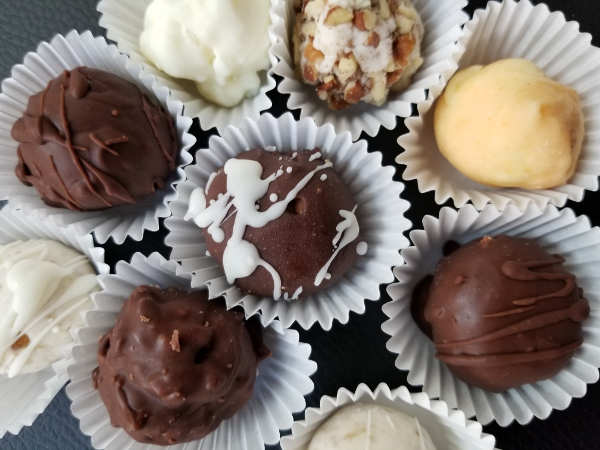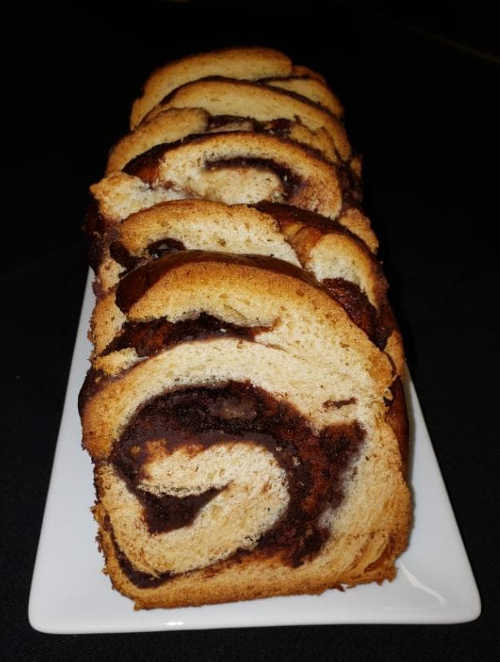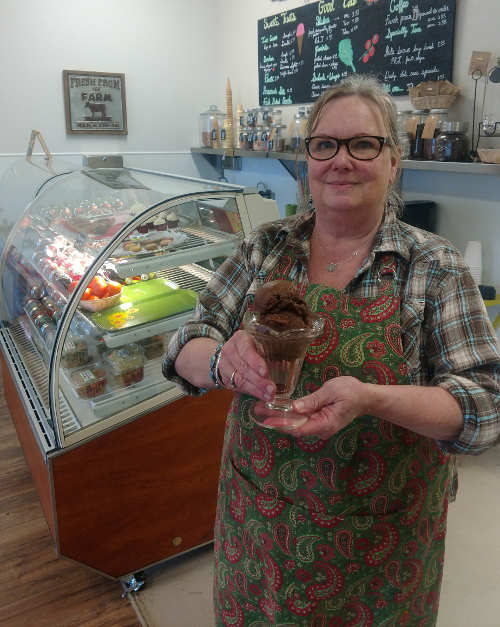
LAKE COUNTY, Calif. – It’s February, when our hearts turn to love. Or – just maybe – chocolate.
Since this is a culinary column, I’ll write about the latter, but really, sometimes the two are intertwined.
In less than two weeks, vast quantities of the confection will be distributed to loved ones in honor of Valentine’s Day, so let’s learn a bit more about this rich treat.
Though it wasn’t until 1847 that it was made into a solid form, chocolate has been used as a drink for thousands of years, perhaps dating as far back as 1400 B.C.
The Mayans and Aztecs used the beans to produce a fermented, frothy, bitter drink that was used in religious ceremonies, often flavored with chili peppers.
The consumption of chocolate may subtly improve cognitive performance. Experiments with chocolate-fed mice suggest that flavanol-rich cocoa stimulates neurovascular activity, enhancing memory and alertness.
Because chocolate stimulates endorphin production, giving a feeling of pleasure, its effects are often compared to being in love. To many, even the word chocolate evokes a sense of well-being.
As well, chocolate contains serotonin, an antidepressant, and theobromine, caffeine and other substances which are stimulants.
It would seem chocolate can both relax and energize those who consume it.
Chocolate comes from a pineapple-sized, melon-like fruit that grows in the tropics on the cacao tree. These fruits are referred to as pods, and each one holds about 40 cacao (also known as cocoa) beans. The simple brown seeds that reside within the pods, cocoon-like, in sweet, sticky white pulp contain all the ingredients needed to make one of our most beloved food products, chocolate.
After harvesting the pods and removing the beans, the beans are left in piles to ferment and then dry before going to the factory. It’s the fermentation process that produces the rich cocoa flavor in the beans.
At the factory, the beans are roasted (either quick and hot or low and slow, depending on the flavor desired) and then hulled to remove the nib inside. The nib is milled to make chocolate liquor, a rich (non-alcoholic) paste that is the base for any chocolate product.
Some of the chocolate liquor is pressed to extract cocoa butter, the ingredient that makes chocolate taste so rich. With a melting point of about 97 degrees, it’s what causes chocolate to melt on our tongue.
Finally, cocoa powder is ground from what’s left after extracting the cocoa butter.
Then the love happens.
Simple ingredients – chocolate liquor, cocoa butter, sugar and a minor ingredient or two, such as vanilla – go through a series of processes (such as conching, which is extensive kneading to develop flavor, and tempering, which is heating and cooling to make chocolate glossy, break with a snap, and melt in our mouths) and become the sweet treat that nearly all of us love.
Because of the health benefits associated with chocolate – particularly dark chocolate – many chocolate manufacturers list the percentage of chocolate liquor (typically noted as cacao) on their dark chocolate products. While more chocolate liquor means greater health benefits, it also means less sugar, so as the percentage increases, the sweetness of the chocolate decreases.
Bittersweet and semisweet chocolate (of which there is no official difference) must contain at least 35 percent chocolate liquor.
If you’re cooking with bitter- or semisweet chocolate, staying below 60 percent chocolate liquor is a good idea, unless your recipe calls for a chocolate with a higher percentage, as the dish may turn out more bitter than intended.
Couverture is a term used for chocolates that are extra rich in cocoa butter, such as the brands used by pastry chefs and sold in specialty stores.
White chocolate is so named because it contains cocoa butter but no chocolate liquor. Be cautious if you want the real stuff – there are products such as “white baking chips” that don’t contain a drop of cocoa butter and you can taste the difference!
Cocoa nibs are sold in natural food or specialty stores and they make for a crunchy little treat, full of intense chocolate flavor. (They’re unsweetened, so be prepared!) They can be tossed in salads, added to breads, or even mixed with asparagus and prosciutto for a delicious and interesting side dish.
As with coffee and wine, the area in which cacao beans are harvested, as well as the type of tree on which they’re grown, contribute greatly to their flavor profile. In other words, there’s a terroir associated with chocolate.
Cacao is harvested in Africa, Mexico, Central America, Asia, and in the Caribbean, and areas within each locale offer their own differences in flavor.
For example, beans grown in Madagascar are said to have citrus overtones, in Panama roasted nut flavors, in Trinidad cinnamon spiciness, and in Jamaica subtle notes of pineapple.
Chocolate can be paired with so many things – from fruits such as raspberries or oranges to chicken when used in a Mexican mole sauce – that it’s really quite a versatile food.
As far as pairings go, chocolate and wine are a comforting classic. I reached out to local wineries to find out which Lake County wines are recommended as sipping companions for chocolate. Many responded, and the result is a list of wines, along with comments from winery staff, which can be found below.
So where do I get my chocolate fix?
When I get a hankering for chocolate, I often head over to the Middletown Creamery if they’ve got their house-made chocolate sorbet on hand. With cinnamon and a hint of heat, it’s reminiscent of Mexican hot chocolate. (No wonder I love it so!)
For something richer and a bit more decadent, Hidden Valley Lake-based truffle maker Linda Moran never fails to disappoint. She recently created a dark chocolate truffle flavored with star anise, which just goes to show that chocolate pairing possibilities are copious!
As luck would have it, students in the Woodland Community College Advanced Pastry Class in Clearlake made chocolate babka on Monday, and Chef Instructor AnnMarie Pleskaczewski has generously agreed to share the recipe they used.
In her opinion, “this bread would be an amazing part of a Valentine’s Day breakfast as French toast with a dollop of crème fraiche, a drizzle of honey, and some sliced strawberries.”
The babka recipe is below, as well as two chocolate recipes of my own, Chocolate Lavender Truffles (a worthy Valentine’s Day gift) and Spiced Mayan Coffee, an interesting pick-me-up on a dreary winter morning.
Bon appétit! And happy Valentine’s Day, just a little bit early.

Chocolate Babka
Babka dough ingredients (Makes 2 9x5-inch loaves)
6⅓ cups (792 grams) all-purpose flour
¾ cup (150 grams) granulated sugar
1 tablespoon (9 grams) active dry yeast
1 tablespoon orange zest
4 large eggs
¾ cup warm whole milk (105°F to 110°F)
1 teaspoon vanilla extract
1 cup (227 grams) unsalted butter, softened
1 tablespoon (9 grams) kosher salt
Egg Wash:
1 large egg
1 tablespoon water
Simple Syrup:
½ cup (100 grams) granulated sugar
½ cup water
Instructions
1. For dough: In the bowl of a stand mixer fitted with the dough hook attachment, combine flour, sugar, yeast, and zest. With mixer on low speed, add eggs, milk, and vanilla. Beat until mixture comes together, 2 to 3 minutes. (If the mixture remains too dry and crumbly, add more milk, 1 tablespoon at a time.)
2. With mixer on medium speed, add butter, 1 tablespoon (14 grams) at a time, letting each piece incorporate before adding the next. Add salt, beating just until combined, about 3 minutes. Increase mixer speed to medium and beat until a smooth and elastic dough forms and pulls away from the sides of the bowl. (If dough does not pull away from the bowl, add more flour, 1 tablespoon [8 grams] at a time.)
3. Spray a large bowl with cooking spray. Place dough in bowl, turning to grease top. Cover and let rise in a warm, draft-free place (75°F) until doubled in size, 1½ to 2½ hours. After dough has risen, refrigerate for 30 minutes. Alternatively, the dough can be made one day in advance and the entire rise may take place in the refrigerator overnight.
4. For egg wash: In a small bowl, lightly beat together egg and water.
5. Spray 2 (9x5-inch) loaf pans with cooking spray, and line with parchment paper.
6. Divide dough in half. On a heavily floured surface, roll half of dough into a 16x12-inch rectangle. Brush edges of dough with egg wash. Spread with half of chocolate filling (recipe below), leaving a 1-inch border on long sides of dough. Starting at one short side, roll up dough, jelly-roll style, and press edge to seal. Using a sharp knife, cut roll in half lengthwise. Carefully twist dough pieces around each other, and place in prepared pan, cut sides up. Repeat procedure with remaining half of dough. Place prepared pans on a foil-lined rimmed baking sheet. Cover and let rise in a warm, draft-free place (75°F) until doubled in size, 1 to 1½ hours.
7. Preheat oven to 350°F. Bake for 30 minutes. Cover with foil, and bake until a thermometer in center registers 190°F, about 35 minutes more.
8. For simple syrup: In a small saucepan, bring sugar and ½ cup water to a boil over medium-high heat, stirring occasionally, until sugar is dissolved. Remove from heat and let cool slightly. Pour simple syrup over warm loaves while still in pans. Let cool in pans for 5 minutes before transferring to a wire rack.
Chocolate filling (Makes enough for 2 loaves)
Ingredients
1 cup (170 grams) semisweet chocolate morsels
¾ cup (170 grams) unsalted butter
¾ cup (90 grams) confectioners’ sugar
⅓ cup (25 grams) unsweetened cocoa powder
1 teaspoon (3 grams) kosher salt
Instructions
In a medium saucepan, melt chocolate and butter over medium heat, stirring frequently to prevent scorching, until chocolate is melted and smooth. Remove from heat, and whisk in confectioners’ sugar, cocoa, and salt. Let cool to room temperature before using.
Recipe courtesy of Chef Instructor AnnMarie Pleskaczewski and the Woodland College Advanced Pastry Class.
Chocolate Lavender Truffles
This recipe is from one of my holiday culinary classes where lavender was featured. Though lavender season is in early summer, culinary lavender may be purchased at spice stores, specialty food markets, and even online.
Note: The same procedure can be used to infuse other flavors into the chocolate, such as cinnamon, orange or vanilla. In those cases, cinnamon sticks, strips of orange zest, or a couple vanilla pods are substituted for the lavender.
Ingredients
1 cup heavy cream
1 teaspoon dried lavender florets
12 ounces bittersweet or semisweet chocolate
1 cup unsweetened cocoa
Procedure
Grate or roughly chop chocolate and put in heat proof bowl.
Bring cream and lavender to a simmer and simmer for one minute; strain.
Add hot lavender-infused cream to chocolate and stir to melt. Mix well.
Chill at least 3 hours. (You may spread on parchment paper on a baking sheet.)
Roll into 1-inch balls and then roll in cocoa.
This recipe makes about 25 truffles, which should be refrigerated until ready to be served.
Recipe by Esther Oertel
Spiced Mayan Coffee
This recipe is from a culinary class I taught on chocolate. It includes three of my favorite pairings with chocolate, coffee, cinnamon, and rich cream, and harkens back to the way it was enjoyed centuries ago. Enjoy!
Ingredients
For every two servings, you will need:
2 tsp unsweetened cocoa
4 tsp sugar (1 tbsp plus 1 tsp)
½ tsp cinnamon
¼ tsp cayenne pepper (less cayenne for less heat)
1/8 tsp salt (1 pinch)
1 cup strong hot coffee
1 cup hot milk
½ tsp vanilla
4 tbsp (approximately) freshly whipped cream
Procedure
Place dry ingredients (through salt) in large Pyrex measuring cup and stir to combine.
Add hot coffee, then hot milk, stirring to combine. (Or, for froth, whir hot milk & dry ingredients in a blender before adding coffee.)
Pour into individual coffee cups and top with a dollop of freshly whipped cream.
Sprinkle with cinnamon and cayenne pepper.
Recipe by Esther Oertel
Wine and chocolate pairing
So you want to pair Lake County wines with chocolate? Here’s a list.
Boatique Winery – Their 2017 Cabernet Sauvignon is recommended as a great pair for chocolate.
Cache Creek Vineyards & Winery – The 2017 Rosé, the 2015 Reserve Cabernet, and the 2015 Petite Sirah are all recommended as stellar pairings for chocolate.
Fults Family Vineyards – They recommend their Old Vine Zinfandel Dessert Wine called GBR (which stands for Go, Big Red!).
Gregory Graham Wines – Gregory Graham notes that their Zinfandel is well known for pairing well with chocolate. He says it’s very jammy (meaning there’s some residual sugar) and almost port-like.
Laujor Estate Winery – They recommend their 2017 Angelina’s Blend Cabernet. It has notes of raspberry and soft cocoa, which make it a great pairing for chocolate. Also recommended is their 2018 Syrah Noir, a dessert wine noted as “big, bold and jammy.”
Mt. Konocti Winery – The Tempranillo from this winery is recommended as a great pairing for chocolate.
Olof Cellars – Their Barbera or Malbera is recommended for chocolate pairing, as well as their signature Nebiollo-Barbera blend. Cindi Olof creates unique food and wine pairings of her own, including chocolate s’mores using marshmallows made with their wine.
R Vineyards – Vineyard owner Monica Rosenthal recommends their Old Wine Zinfandel from vines planted in 1937. Its jamminess and notes of blackberry, chocolate, and cinnamon make it a great pairing for chocolate.
Shannon Ridge Family of Wines - Molly Wingo, winemaker, says, “I really like our High Elevation Petite Sirah, which has a mocha note that goes well with both milk and dark chocolate. The other is our Vigilance Cabernet Sauvignon, which has a nice spiciness that pairs well with any chocolate. I especially like it with milk chocolate. As for white chocolate, I would pair it with our High Valley Sauvignon Blanc for contrast, or the High Valley Rose’ to bring out some of the strawberry notes.”
Six Sigma Ranch, Vineyard & Winery – Six Sigma’s 2015 Dessert Wine, a port-like wine made from Tempranillo grapes, is recommended as a pairing for chocolate. Though currently sold out, it will reappear in the future, so keep your eyes peeled! The brandy used in this fortified wine is distilled from their own wines.
Steele Wines – Their Catfish Zinfandel, made from grapes grown on vines that are 119 years old, is recommended as the best pairing for chocolate, though I was told that many of their wines may be paired with a chocolate that best matches the varietal.
Esther Oertel is a writer and passionate home cook from a family of chefs. She grew up in a restaurant, where she began creating recipes from a young age. She’s taught culinary classes in a variety of venues in Lake County and previously wrote “The Veggie Girl” column for Lake County News. Most recently she’s taught culinary classes at Sur La Table in Santa Rosa, Calif. She lives in Middletown, Calif.


 How to resolve AdBlock issue?
How to resolve AdBlock issue? 



